Hazardous goods international shipping is subject to diverse regulatory regimes. Therefore, understanding the classification of dangerous goods is pivotal in ensuring safe and secure transportation.
This article will provide further insights into the classes and subdivisions of dangerous goods so that you can determine specific regulations for their packaging and labeling.
Table of Contents:
- What are the dangerous goods?
- The purpose of the classification of dangerous goods
- Class 1: Explosive substances and examples
- Class 2: Gases and gaseous substances
- Class 3: Flammable liquids overviews
- Class 4: Flammable solids and articles
- Class 5: Flammable substances
- Class 6: Toxic and infectious materials
- Class 7: Radioactive substances
- Class 8: Corrosive substances
- Class 9: Miscellaneous dangerous goods
- Shipping hazardous materials internationally hassle-free
What are the dangerous goods?
Dangerous goods, often termed hazardous materials or hazmat, refer to any substance that potentially poses an excessive risk to health, safety, and property when shipped internationally.
The notion seldom occurs to us, yet many everyday used items are considered hazardous cargo. For instance, lithium batteries, dry ice, handwashing liquids, and similar products all fall within this category. Improper handling of these items can result in leakage, the emission of toxic fumes, ignition, or even explosive reactions.
The purpose of the classification of dangerous goods
Shipping dangerous goods needs meticulous and specific logistics strategies based on their inherent properties; otherwise, potential accidents, such as fire or cargo damage, may occur during transportation.
However, hazardous goods encompass different types and hazard levels, including explosives, toxic substances, flammable items, etc.
As for this, classifying dangerous goods enables people to identify the hazards associated with each type of material and undertake corresponding safety measures.
It empowers carriers to promptly take appropriate actions in case of accidents, spills, or other emergencies during transportation.
Furthermore, classification forms the foundation for regulations and guidelines established by international and national regulatory bodies.
These regulations govern packaging, labeling, handling, and transportation requirements for each class of hazardous material, ensuring uniformity and standardization in their movement across borders.
As you can see, the dangerous goods classification is vital for ensuring safety, regulatory compliance, and efficient transportation.
In the following sections, we will delve deeper into each hazardous class. Break down the unique risks and characteristics related to every category of dangerous goods.
Class 1: Explosive substances
Explosives refer to substances or objects that can swiftly ignite or detonate due to a chemical reaction. They have the potential to cause catastrophic damage at extreme temperatures and pressures by a powerful force, producing significant heat, sound, gas, or smoke.
Division 1.1: Mass explosion hazard
These items can cause massive destruction when detonated, even if only a part is involved in initiation.
Division 1.2: Projection hazard
They pose risks primarily due to the projection of fragments but have a lesser explosion risk than Division 1.1.
Division 1.3: Fire hazard
Materials and items possess a fire hazard and either a minor blast risk, a minor projection threat, or both.
Division 1.4: Minor blast hazard
These have a low likelihood of causing damage and are used in day-to-day activities. Safety matchboxes fall under this category.
Division 1.5: Very insensitive explosives
Articles have a mass explosion hazard but are so insensitive that there is a low probability of accidental initiation or propagation.
Division 1.6: Extremely insensitive articles
Substances lack a mass explosion hazard and exhibit such insensitivity that there is virtually no risk of accidental initiation.
| 1.1 | 1.2 | 1.3 | 1.4 | 1.5 | 1.6 |
|---|---|---|---|---|---|
| Dynamite, TNT (Trinitrotoluene) | Ammunition, fireworks | Pyrotechnics | Small arms ammunition, igniters | Blasting agents | Minimal risk of accidental initiation |
To convenience you, below is a simplified chart outlining the classification of class 1 dangerous goods with their respective labeling:
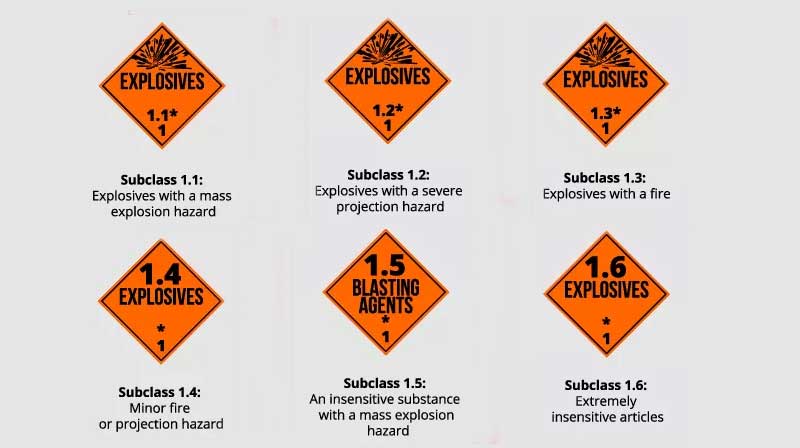
Class 2: Gases and gaseous substances
Class 2 hazardous materials have specific risks due to their potential for flammability, toxicity, or asphyxiation.
Generally, Dangerous Goods Regulations(DGR) categorize gases as substances with a vapor pressure of 300 kPa or higher at 50°C. Or exist entirely in a gaseous state at 20°C under standard atmospheric pressure.
This definition also extends to items that contain these gas substances.
Division 2.1: Flammable gases
Materials that can ignite in the presence of an ignition source, such as a flame or spark, and continue to burn.
Division 2.2: Non-Flammable gases
Gases that are not flammable but can still pose risks, such as asphyxiation or displacement of oxygen in confined spaces.
Division 2.3: Toxic gases
Gases that, when inhaled, can cause toxic effects or pose health risks to individuals exposed to them.
| 2.1 | 2.2 | 2.3 |
|---|---|---|
| Propane, butane, methane | Carbon dioxide, nitrogen, helium | Chlorine, ammonia, hydrogen sulfide |
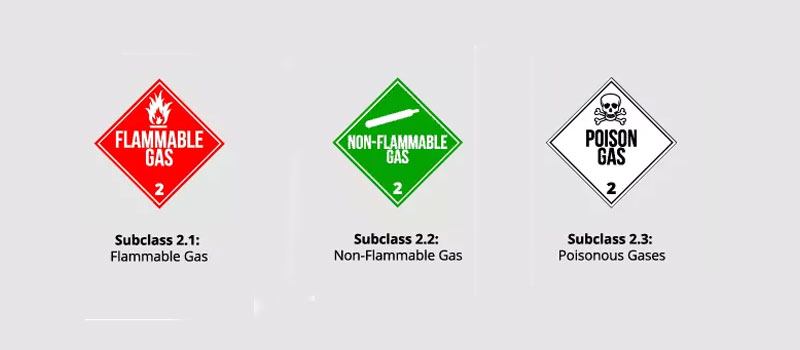
Class 3: Flammable liquids
Class 3 comprises liquids that have a flashpoint not more than 60°C (140°F) and can ignite and burn easily at homoeothermy. These liquids present significant risks owing to their volatility, rapid ignition, and potential to initiate or spread intense fires.
Characteristics of flammable liquids:
- Flammable liquids are susceptible to ignition from various sources, such as sparks, flames, or heat.
- They release vapors that can ignite and sustain combustion, posing fire hazards.
Commonly transported class 3 dangerous goods
Gasoline, alcohol(Ethanol), perfumery products, acetone, paint thinner, diesel fuel, methanol, organochlorine pesticides, etc.
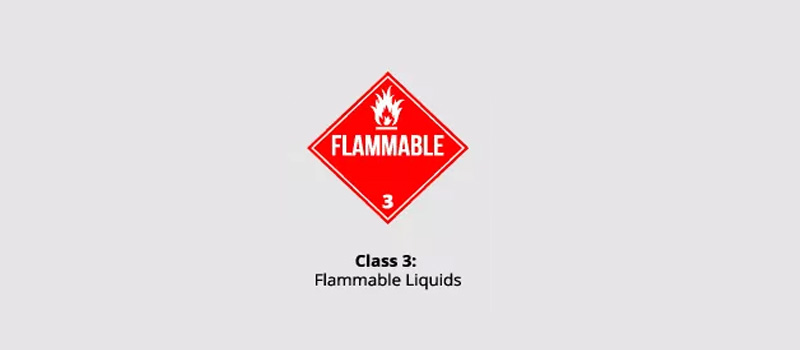
Class 4: Flammable solids and articles
Class 4 dangerous goods consist of substances that can easily ignite in a solid state. They can sustain combustion through friction or brief contact with an ignition source.
Additionally, this classification included materials prone to self-heating under normal transport conditions or upon exposure to air, leading to a risk of ignition.
Sub-division within class 4
Division 4.1: Flammable solids
Solid materials that are readily combustible or can contribute to fires through friction, self-reactivity, or moisture absorption.
Division 4.2: Substances liable to spontaneous combustion
This hazardous material will undergo spontaneous combustion due to heat generation in the absence of external ignition sources.
Division 4.3: Substances that emit flammable gases when in contact with water
Articles that, upon contact with water or moisture, can release flammable gases, leading to fire or explosion hazards.
Examples of commonly transported class 4 Dangerous goods
| 4.1 | 4.2 | 4.3 |
|---|---|---|
| Matches, certain metal powders, sulfur | Phosphorus, certain coal products | Calcium carbide, metallic sodium |
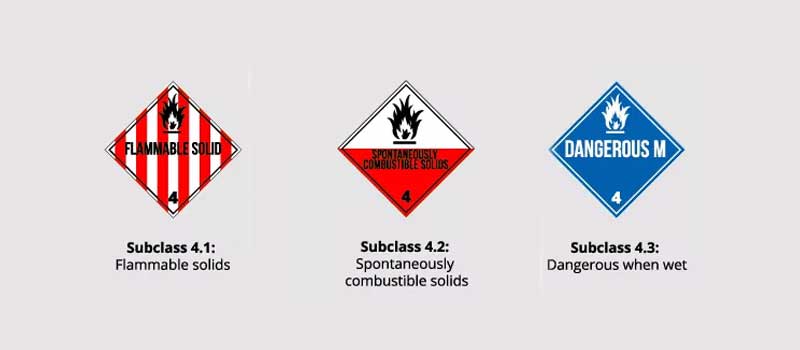
Class 5: Flammable substances
According to DGR, Oxidizers fall under Class 5 dangerous goods. These substances typically produce oxygen through a redox chemical reaction.
While not inherently combustible, Oxidizers can generate oxygen, thereby initiating or contributing to the combustion of other materials.
Classification codes of flammable
Division 5.1: Oxidizing substances
These items enhance the combustion of other materials by releasing oxygen, thereby increasing the risk of fire.
Division 5.2: Organic peroxides
Organic compounds are prone to exothermic decomposition and are sensitive to impact or friction, which can result in rapid combustion or explosion under certain conditions.
Examples of commonly transported class 5 DG goods
| 5.1 | 5.2 |
|---|---|
| Hydrogen peroxide, potassium permanganate, chemical oxygen generators | Benzoyl peroxide, hydroperoxide, magnesium peroxide |
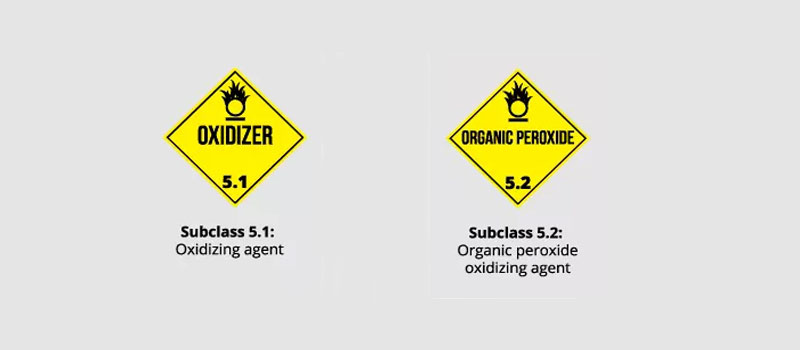
Class 6: Toxic and infectious materials
Class 6 hazardous substances can cause harm to human health or the environment if not handled correctly during international shipping.
Sub-division for class 6 dangerous goods
Division 6.1: Toxic substances
Hazmat that, when inhaled, swallowed, or absorbed through the skin, can cause illness, injury, or even death.
Division 6.2: Infectious substances
Infectious items refer to materials that either are known or have a reasonable expectation of containing pathogens. According to DGR, pathogens include bacteria, viruses, parasites, fungi, or other agents capable of causing diseases in humans or animals.
Examples of commonly transported toxic materials
| 6.1 | 6.2 |
|---|---|
| Pesticides, certain chemicals, some pharmaceuticals, dyes, acids, nicotine | Biological samples, some pathogens, infectious waste, medical waste |
Class 6 dangerous goods classification chart
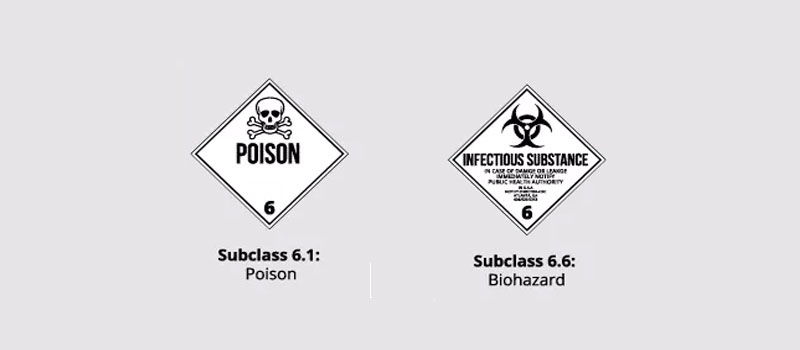
Class 7: Radioactive substances
Class 7 dangerous goods classification involves items containing radionuclides, surpassing specific pre-defined values in activity concentration and total activity.
These materials possess unstable atomic nuclei, leading to the spontaneous emission of particles or energy in the form of radiation.
During radioactive decay, radionuclides emit ionizing radiation, posing potentially severe risks to human health.
Common examples of transported radioactive materials (RAM) include uranium, plutonium, radioactive ores, mixed fission products, medical isotopes, and more.

Class 8: Corrosive substances
Corrosive substances refer to materials capable of inflicting severe damage on living tissue, other substances, or the environment through chemical reactions, often leading to corrosion or erosion.
Commonly transported examples of class 8 dangerous goods include:
Sulfuric acid, hydrochloric acid, fire extinguisher charges, sodium hydroxide, potassium hydroxide, battery fluid, fuel cell cartridges, formaldehyde, paints, and similar items.
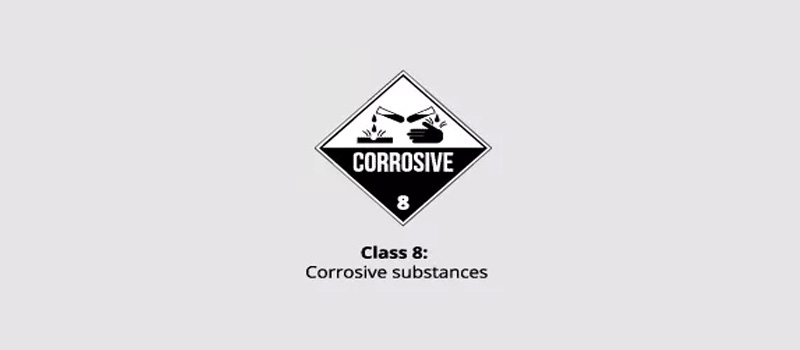
Class 9: Miscellaneous dangerous goods
Class 9, often called miscellaneous dangerous goods, includes hazardous materials that don’t fall under the previous eight classes but still pose risks during transportation.
Examples of Class 9 dangerous goods:
- Environmental hazards that don’t fit class 5 (oxidizers) or class 6 (toxic or infectious substances). Items such as certain pesticides or substances harmful to aquatic life.
- Substances with corrosive properties that do not meet the criteria of class 8 (corrosive substances). Examples may include some acidic or alkaline solutions that present mild corrosive risks.
- Magnetized materials or items that pose a hazard in transportation due to their magnetic field.
- Articles with inherent risks that do not fit into a designated hazardous goods classification.
Other commonly transported miscellaneous dangerous goods include:
Lithium metal batteries, lithium-ion batteries, dry ice, vehicles, first aid kits, genetically modified organisms, life-saving appliances, and more.
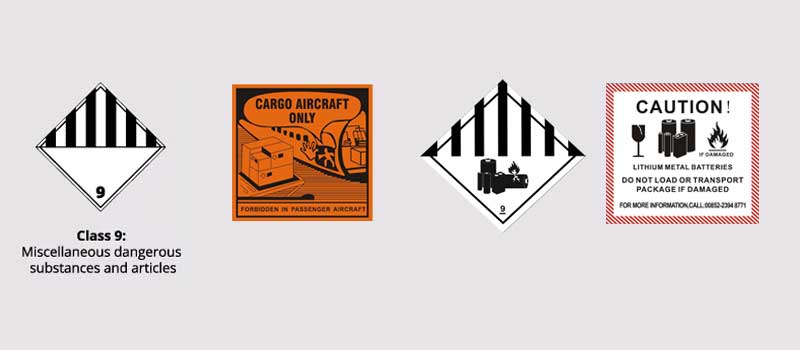
How to ship hazardous materials internationally hassle-free?
To alleviate the complexities of handling dangerous goods, you can partner with Airsupply, a premier expert in DG cargo based in China.
With experience in managing over 100 dangerous goods shipments per week across classes 2, 3, 5, 6, 8, and 9, we ensure compliance with international and national shipping regulations for each classification.
Our expertise extends to air, sea, and railway freight, encompassing adept knowledge of packing and labeling prerequisites for DG cargo. This proficiency guarantees smooth customs clearance processes and timely deliveries.




